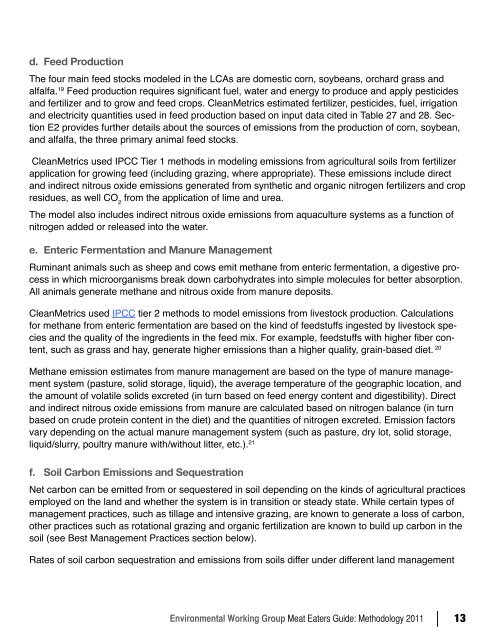Meat Eaters Guide: Methodology - Environmental Working Group
Meat Eaters Guide: Methodology - Environmental Working Group
Meat Eaters Guide: Methodology - Environmental Working Group
You also want an ePaper? Increase the reach of your titles
YUMPU automatically turns print PDFs into web optimized ePapers that Google loves.
d. Feed Production<br />
The four main feed stocks modeled in the LCAs are domestic corn, soybeans, orchard grass and<br />
alfalfa. 19 Feed production requires significant fuel, water and energy to produce and apply pesticides<br />
and fertilizer and to grow and feed crops. CleanMetrics estimated fertilizer, pesticides, fuel, irrigation<br />
and electricity quantities used in feed production based on input data cited in Table 27 and 28. Section<br />
E2 provides further details about the sources of emissions from the production of corn, soybean,<br />
and alfalfa, the three primary animal feed stocks.<br />
CleanMetrics used IPCC Tier 1 methods in modeling emissions from agricultural soils from fertilizer<br />
application for growing feed (including grazing, where appropriate). These emissions include direct<br />
and indirect nitrous oxide emissions generated from synthetic and organic nitrogen fertilizers and crop<br />
residues, as well CO 2 from the application of lime and urea.<br />
The model also includes indirect nitrous oxide emissions from aquaculture systems as a function of<br />
nitrogen added or released into the water.<br />
e. Enteric Fermentation and Manure Management<br />
Ruminant animals such as sheep and cows emit methane from enteric fermentation, a digestive process<br />
in which microorganisms break down carbohydrates into simple molecules for better absorption.<br />
All animals generate methane and nitrous oxide from manure deposits.<br />
CleanMetrics used IPCC tier 2 methods to model emissions from livestock production. Calculations<br />
for methane from enteric fermentation are based on the kind of feedstuffs ingested by livestock species<br />
and the quality of the ingredients in the feed mix. For example, feedstuffs with higher fiber content,<br />
such as grass and hay, generate higher emissions than a higher quality, grain-based diet. 20<br />
Methane emission estimates from manure management are based on the type of manure management<br />
system (pasture, solid storage, liquid), the average temperature of the geographic location, and<br />
the amount of volatile solids excreted (in turn based on feed energy content and digestibility). Direct<br />
and indirect nitrous oxide emissions from manure are calculated based on nitrogen balance (in turn<br />
based on crude protein content in the diet) and the quantities of nitrogen excreted. Emission factors<br />
vary depending on the actual manure management system (such as pasture, dry lot, solid storage,<br />
liquid/slurry, poultry manure with/without litter, etc.). 21<br />
f. Soil Carbon Emissions and Sequestration<br />
Net carbon can be emitted from or sequestered in soil depending on the kinds of agricultural practices<br />
employed on the land and whether the system is in transition or steady state. While certain types of<br />
management practices, such as tillage and intensive grazing, are known to generate a loss of carbon,<br />
other practices such as rotational grazing and organic fertilization are known to build up carbon in the<br />
soil (see Best Management Practices section below).<br />
Rates of soil carbon sequestration and emissions from soils differ under different land management<br />
<strong>Environmental</strong> <strong>Working</strong> <strong>Group</strong> <strong>Meat</strong> <strong>Eaters</strong> <strong>Guide</strong>: <strong>Methodology</strong> 2011 13



